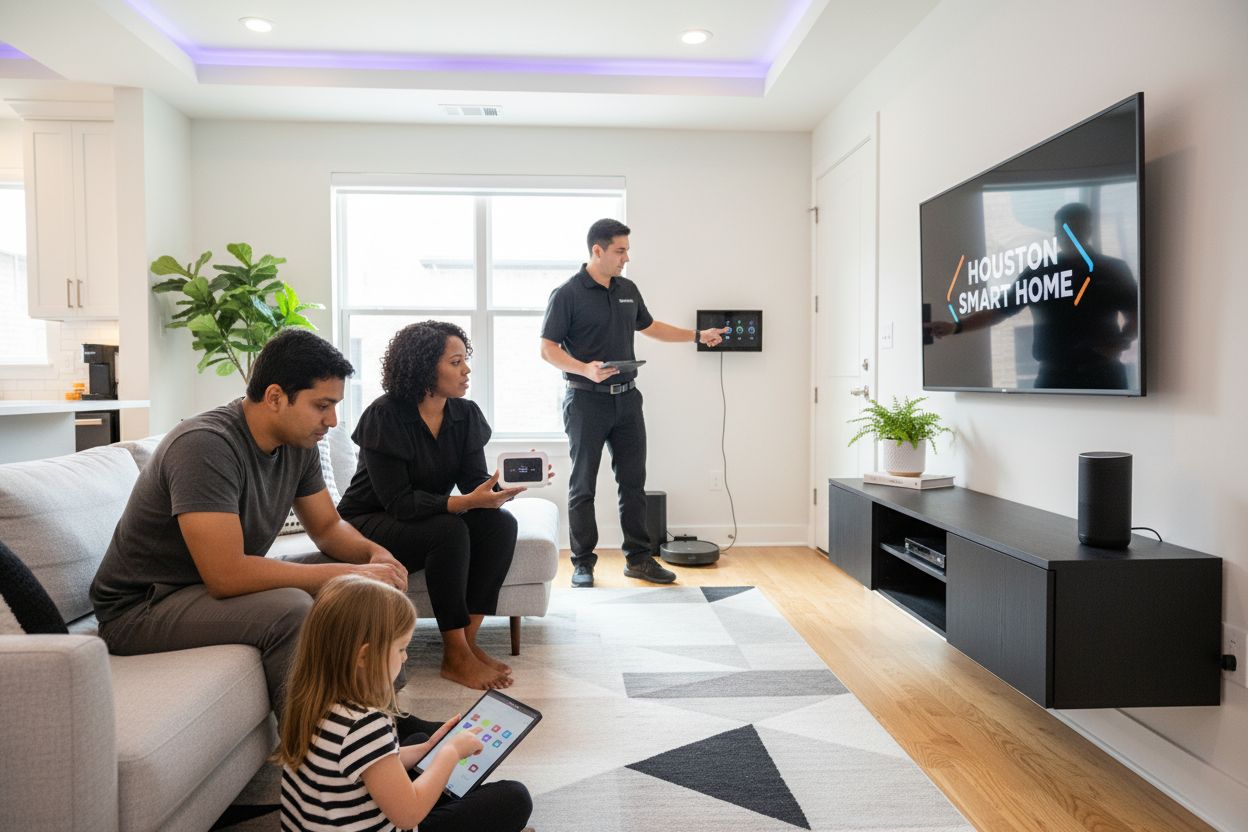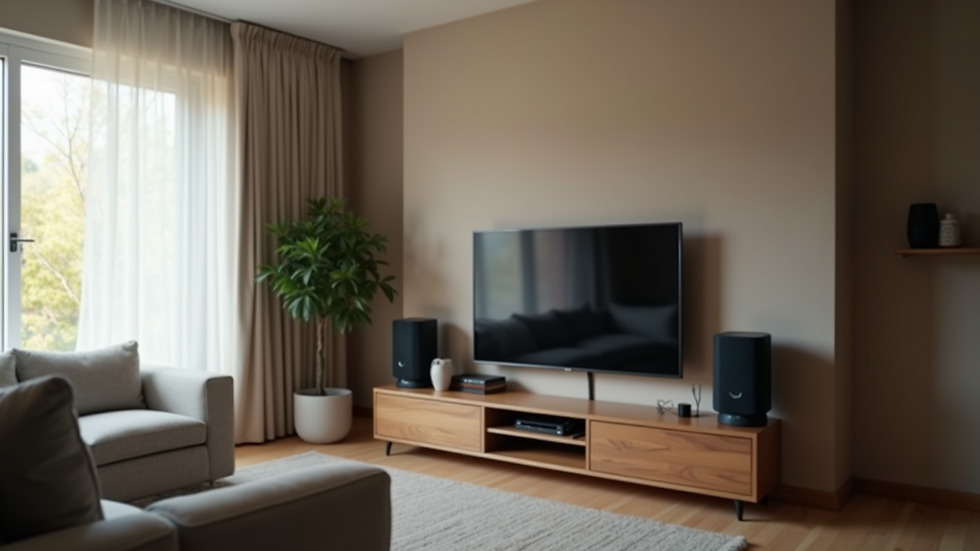10 Smart Home Installation Tips for Houston Homeowners
- garygarihanjr
- Oct 2
- 11 min read

Houston homeowners are adding smart home technology faster than ever. In fact, over 53% of smart device owners now rely on voice control as their main way to interact with their homes. Surprise, though. Getting these systems up and running is not as simple as just plugging in some gadgets. The unexpected challenge is that details like wiring quality, strong Wi-Fi, and expert installation actually make the biggest difference in how smoothly your smart home works.
Table of Contents
Quick Summary
Takeaway | Explanation |
Assess your home’s wiring first | Evaluate your existing electrical system to identify compatibility and upgrade needs before installing smart devices. |
Choose a compatible smart home ecosystem | Select an ecosystem that supports various devices and offers strong security measures for future integration. |
Budget for initial and ongoing costs | Plan for device purchases, installation, maintenance, and future upgrades to avoid unexpected expenses. |
Ensure device compatibility | Verify that your smart devices can communicate smoothly using standard protocols to prevent system conflicts. |
Prioritize security features | Implement robust security practices, including encryption and guest networks, to protect your smart home from digital threats. |
1: Assess Your Home’s Current Wiring and Connectivity
Before diving into smart home installation, understanding your home’s existing electrical infrastructure is crucial. Houston homeowners must conduct a comprehensive evaluation of their current wiring and connectivity to ensure a smooth and safe smart home transformation.
Starting with a professional electrical assessment helps identify potential challenges and compatibility issues. Structured cabling installation becomes essential in creating a robust network foundation for your smart home ecosystem.
Key areas to evaluate during your home’s connectivity assessment include:
Electrical panel capacity and available circuits
Network infrastructure and internet bandwidth
Existing wiring quality and potential upgrade requirements
Location of power outlets relative to planned smart device placements
A detailed inspection by a licensed electrician can reveal critical insights. According to National Electrical Contractors Association, homes built before 2000 often require significant electrical system upgrades to support modern smart home technologies.
Professional assessment goes beyond visual inspection. Specialized diagnostic tools can measure electrical load, identify potential interference sources, and recommend optimal positioning for smart home devices. This proactive approach prevents future installation complications and ensures seamless technology integration.
Budget-conscious homeowners should recognize that investing in a comprehensive wiring evaluation prevents costly retrofitting or system incompatibilities down the line. Remember, a solid electrical foundation is the backbone of any successful smart home implementation.
2: Choose the Right Smart Home Ecosystem
Selecting the appropriate smart home ecosystem represents a critical decision that will impact your entire home automation strategy. Houston homeowners must carefully evaluate compatibility, scalability, and long term integration potential before committing to a specific platform.
Understanding smart home technology begins with recognizing the major ecosystem players and their unique strengths. The primary smart home ecosystems typically include:
Apple HomeKit for privacy focused users
Google Home for seamless AI integration
Amazon Alexa for extensive device compatibility
Samsung SmartThings for robust third party support
According to Statista, market penetration and device ecosystem compatibility should be primary considerations when selecting your platform. Professional installers recommend choosing an ecosystem that offers:
Comprehensive device support
Strong security protocols
Regular software updates
Intuitive user interface
Your selected ecosystem should provide flexible integration capabilities that allow future expansion and technological upgrades. This forward thinking approach prevents potential obsolescence and ensures your smart home remains adaptable to emerging technologies.
Professional consultation can help evaluate which ecosystem best matches your specific home configuration, technological preferences, and budget constraints. Remember that ecosystem selection is not just about current capabilities but also potential future developments in home automation technology.
3: Plan Your Budget for Smart Devices
Budgeting for smart home technology requires strategic planning and a clear understanding of both immediate and long term investment requirements. Houston homeowners must approach smart device procurement with careful financial consideration to maximize value and prevent unexpected expenses.
Luxury home upgrade strategies emphasize the importance of creating a comprehensive technology budget that accounts for various factors beyond initial device costs.
According to Consumer Technology Association, typical smart home technology budgets range from $1,500 to $5,000 depending on home size and complexity. Essential budget considerations include:
Initial device acquisition costs
Professional installation expenses
Ongoing maintenance and software subscriptions
Future expansion and upgrade potential
Key budgeting strategies for smart home investments involve:
Prioritizing critical functionality over aesthetic features
Selecting scalable devices with future compatibility
Researching potential energy savings and long term cost benefits
Considering potential increases in home value
Homeowners should recognize that smart home technology represents an investment in convenience, efficiency, and property value. While upfront costs might seem substantial, many devices offer significant long term returns through energy savings, improved home security, and enhanced living experiences.
Professional consultation can help create a tailored budget that aligns with your specific technological goals and financial constraints. Smart budgeting ensures you build a robust, adaptable home automation system without unnecessary financial strain.
4: Understand Compatibility of Devices
Device compatibility represents a critical foundation for successful smart home integration. Houston homeowners must carefully evaluate technological interoperability to prevent potential system fragmentation and communication breakdowns.
Understanding smart home technology examples highlights the complexity of creating a seamless technological ecosystem within residential spaces. Compatibility goes beyond simple connection protocols and requires deep understanding of communication standards.
According to Zigbee Alliance, modern smart home devices typically operate using several primary communication protocols:
WiFi for high bandwidth applications
Bluetooth Low Energy for proximity based interactions
Zigbee for mesh network capabilities
Z-Wave for reliable home automation networks
Key compatibility considerations include:
Verifying device communication standards
Checking firmware update potential
Ensuring cross platform functionality
Evaluating manufacturer support and integration capabilities
Professional installers recommend creating a unified communication framework that allows diverse devices to interact seamlessly. This approach minimizes potential technological conflicts and ensures smooth operational integration.
Technological standards continue evolving rapidly. Homeowners should prioritize devices with open communication protocols and manufacturer commitments to ongoing software development. Investing in adaptable, standards compliant devices prevents future obsolescence and creates a more resilient smart home infrastructure.
5: Prioritize Security Features in Your Setup
Smart home security extends far beyond traditional alarm systems. Houston homeowners must implement comprehensive digital protection strategies that safeguard both physical infrastructure and network connectivity.
Home networking best practices emphasize the critical nature of proactive cybersecurity measures in modern residential technology environments.
According to Norton Cybersecurity, smart home vulnerabilities can expose households to significant digital risks. Critical security considerations include:
Encrypted network communications
Two factor authentication
Regular firmware updates
Isolated guest networking
Essential security strategies for smart home installations involve:
Implementing robust password management
Creating separate networks for IoT devices
Monitoring device access logs
Utilizing professional security configuration services
Professional installers recommend multi layered security approaches that combine hardware and software protections. This means selecting devices with built in encryption, maintaining strict access controls, and continuously updating system configurations.
Cybersecurity is not a one time configuration but an ongoing process. Homeowners should schedule regular security audits, stay informed about emerging digital threats, and work with technology professionals who understand the nuanced landscape of smart home protection. By treating digital security with the same seriousness as physical home security, Houston residents can create resilient and protected smart home environments.
6: Optimize Wi-Fi Coverage for Smart Devices
Optimal Wi-Fi coverage represents the backbone of successful smart home technology integration. Houston homeowners must develop a strategic approach to network infrastructure that ensures consistent, reliable connectivity across their entire living space.
Smart home troubleshooting techniques highlight the critical importance of comprehensive network planning before device installation.
According to Cisco Networking Insights, effective home network design requires understanding signal propagation and potential interference sources. Critical factors influencing Wi-Fi performance include:
Router placement and signal strength
Frequency band selection
Physical home architectural barriers
Device density and bandwidth requirements
Key strategies for maximizing Wi-Fi coverage involve:
Installing mesh network systems
Using professional signal mapping tools
Selecting dual band or tri band routers
Minimizing signal interference from electronic devices
Professional installers recommend creating a comprehensive wireless network ecosystem that adapts to your home’s unique architectural characteristics. This means understanding signal dead zones, strategically positioning network hardware, and potentially implementing advanced networking solutions like mesh systems or signal repeaters.
Modern smart home environments demand robust, consistent connectivity. By investing in professional network design and high performance networking equipment, Houston homeowners can create a seamless technological infrastructure that supports advanced home automation technologies.
7: Consider Professional Installation Services
Professional smart home installation services bridge the critical gap between technological potential and practical implementation. Houston homeowners gain significant advantages by partnering with experienced technology integration specialists who understand complex system requirements.
Houston AV installation experts demonstrate the nuanced expertise required for seamless smart home deployments. Technical proficiency goes far beyond simple device connection.
According to Consumer Technology Association, professional installation reduces potential system errors by approximately 72% compared to do it yourself approaches. Critical benefits of professional services include:
Comprehensive system design
Precision equipment configuration
Advanced troubleshooting capabilities
Ongoing technical support
Key considerations when selecting professional installation services involve:
Verifying technician certifications
Checking comprehensive service warranties
Understanding post installation support options
Reviewing previous installation portfolios
Professional installers provide sophisticated technological orchestration that transforms disconnected devices into integrated, intelligent home systems. They assess unique architectural characteristics, recommend optimal device placement, and ensure seamless communication between different technological components.
The investment in professional installation extends beyond immediate setup. Experienced technicians create scalable infrastructure that accommodates future technological advancements, protecting your long term smart home vision. By choosing expert installation, Houston homeowners minimize potential complications and maximize their technological investment.
8: Start with Key Areas: Living Room and Kitchen
Smart home technology integration should prioritize high traffic areas that deliver immediate functional and aesthetic benefits. Living rooms and kitchens represent ideal starting points for Houston homeowners seeking transformative technological experiences.
Smart home upgrade strategies emphasize the importance of strategic device selection in core living spaces where technology can significantly enhance daily interactions.
According to National Association of Home Builders, modern homeowners increasingly view technology as an essential component of contemporary living spaces. Critical smart device considerations for living rooms and kitchens include:
Voice controlled entertainment systems
Smart lighting configurations
Intelligent temperature management
Connected kitchen appliances
Strategic implementation strategies involve:
Selecting multi functional devices
Ensuring aesthetic device integration
Maintaining user friendly interfaces
Prioritizing energy efficiency
Living rooms benefit from seamlessly integrated technology that enhances entertainment and comfort. Smart speakers, automated lighting, and intelligent window treatments can transform traditional spaces into responsive environments that adapt to residents preferences.
Kitchens represent technological innovation opportunities with smart refrigerators, voice activated faucets, and connected cooking appliances that streamline meal preparation and kitchen management. By focusing initial smart home investments in these central spaces, Houston homeowners can experience immediate technological value while creating a foundation for future whole home automation.
9: Integrate Voice Control for Ease of Use
Voice control represents the pinnacle of intuitive smart home interaction, transforming complex technological systems into simple, conversational experiences. Houston homeowners can leverage voice activated technologies to create more accessible, responsive living environments.
Smart home automation strategies underscore the transformative potential of voice controlled systems in modern residential settings.
According to Pew Research Center, over 53% of smart home device owners now utilize voice control as their primary interaction method. Critical considerations for voice control integration include:
Compatibility across device ecosystems
Privacy and data protection settings
Accent and language recognition capabilities
Multi user voice profile support
Strategic voice control implementation involves:
Selecting platforms with robust natural language processing
Creating custom voice commands
Establishing clear privacy protocols
Training household members on system interactions
Professional installers recommend developing a comprehensive voice control strategy that balances technological convenience with security and personalization. Voice activated systems can manage everything from lighting and temperature to entertainment and security, creating a truly responsive home environment.
By thoughtfully integrating voice control, Houston homeowners can transform their living spaces into intelligent, responsive ecosystems that understand and anticipate individual preferences. The key lies in selecting flexible, user friendly platforms that prioritize both technological capability and human centered design.
10: Regularly Update Software for Optimal Performance
Software updates represent the critical backbone of maintaining a secure, efficient smart home ecosystem. Houston homeowners must recognize that technological maintenance extends far beyond initial device installation.
Smart home troubleshooting techniques emphasize the importance of proactive software management in preventing potential system vulnerabilities.
According to Cybersecurity and Infrastructure Security Agency, unpatched software represents one of the most significant security risks in connected home environments. Critical update considerations include:
Security patch implementation
Performance optimization
Feature enhancement
Compatibility improvements
Strategic software maintenance involves:
Enabling automatic update settings
Scheduling regular manual review periods
Creating backup configurations
Monitoring manufacturer update announcements
Professional installers recommend developing a systematic approach to software updates that balances system stability with technological advancement. This means not just installing updates, but understanding their potential impact on your entire smart home infrastructure.
Consistent software maintenance protects against emerging cybersecurity threats, ensures optimal device performance, and extends the functional lifespan of your smart home investment.
Below is a comprehensive table summarizing the 10 essential smart home installation tips for Houston homeowners, with each step, its focus, and the primary benefits described.
Step | Focus/What to Do | Primary Benefit |
Assess Wiring & Connectivity | Evaluate electrical system, panel capacity, and networking | Ensures safe and compatible infrastructure |
Choose Smart Home Ecosystem | Select the right platform (Apple, Google, Amazon, Samsung) | Enables seamless integration and scalability |
Plan Budget for Smart Devices | Account for device, installation, maintenance, and upgrades | Prevents overspending and unexpected expenses |
Understand Device Compatibility | Verify communication standards and cross-platform support | Avoids system conflicts and fragmentation |
Prioritize Security Features | Implement strong digital/network protections and practices | Shields against hacking and data breaches |
Optimize Wi-Fi Coverage | Design network for full coverage and minimal dead zones | Maximizes device reliability and performance |
Consider Professional Installation | Use expert services for design, setup, and support | Reduces errors, ensures future-proof setup |
Start with Living Room & Kitchen | Focus initial upgrades in high-traffic, functional areas | Delivers immediate value and usability |
Integrate Voice Control | Add voice assistant features and set up for convenience | Simplifies use, enhances accessibility |
Regularly Update Software | Maintain latest firmware and software across devices | Maintains security and optimal functionality |
Upgrade Your Houston Home With Seamless Smart Technology
Are you feeling overwhelmed by the complexity of smart home integration? From navigating compatibility issues to ensuring reliable Wi-Fi coverage and prioritizing cybersecurity, creating a truly intelligent home can be stressful without expert help. Many Houston homeowners struggle with outdated wiring, fragmented device networks, or uncertainty about which technologies work best together. The article highlighted how these challenges often stand in the way of building a functional, future-ready smart home that fits your unique lifestyle.

Let us take the guesswork out of the process. The team at Techology Experts specializes in customized smart home installations, bringing together structured cabling, elite automation systems, and complete connectivity solutions under one roof. Whether you are interested in structured cabling for better connectivity or want to explore luxury home upgrade strategies, our experts handle everything from the initial assessment to ongoing support. Make the move toward a smarter, more secure, and comfortable home today. Visit Techology Experts now to request your personalized consultation before your next upgrade window closes.
Frequently Asked Questions
What should I evaluate in my home’s current wiring before starting a smart home installation?
Before starting a smart home installation, homeowners should assess their home’s electrical panel capacity, network infrastructure, existing wiring quality, and the location of power outlets relative to planned smart device placements.
How do I choose the right smart home ecosystem for my needs?
Selecting the right smart home ecosystem involves evaluating compatibility, scalability, and long-term integration potential with devices. Consider major ecosystems like Apple HomeKit, Google Home, Amazon Alexa, and Samsung SmartThings, while prioritizing comprehensive device support and robust security protocols.
Why is device compatibility important in a smart home setup?
Device compatibility ensures successful integration and communication between different smart devices. It’s essential to verify communication standards, check for firmware update potential, and ensure cross-platform functionality to avoid system fragmentation.
What are the benefits of professional installation services for smart home technology?
Professional installation services provide benefits like comprehensive system design, precise equipment configuration, and ongoing technical support. They also reduce potential system errors and help create a scalable smart home infrastructure that accommodates future technological advancements.
Recommended

Comments